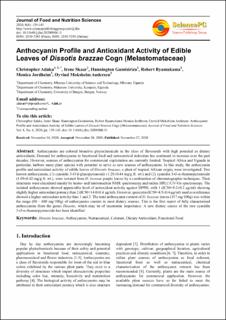Anthocyanin Profile and Antioxidant Activity of Edible Leaves of Dissotis brazzae Cogn (Melastomataceae)
Adaku, Christopher; Skaar, Irene; Gumisiriza, Hannington; Byamukama, Robert; Jordheim, Monica; Andersen, Øyvind M
Journal article
Published version

Åpne
Permanent lenke
https://hdl.handle.net/11250/2761645Utgivelsesdato
2020Metadata
Vis full innførselSamlinger
- Department of Chemistry [433]
- Registrations from Cristin [9791]
Originalversjon
Journal of Food and Nutrition Sciences. 2020, 8(6), 139-145Sammendrag
Anthocyanins are colored bioactive phytochemicals in the class of flavonoids with high potential as dietary antioxidants. Demand for anthocyanins in functional food and nutraceutical industries has continued to increase over the past decades. However, sources of anthocyanins for commercial exploitation are currently limited. Tropical Africa and Uganda in particular, harbors many plant species with potential to serve as new sources of anthocyanins. In this study, the anthocyanin profile and antioxidant activity of edible leaves of Dissotis brazzae, a plant of tropical African origin, were investigated. Two known anthocyanins, (1) cyanidin 3-O-β-glucopyranoside (1.28±0.44 mg/g fr. wt.) and (2) cyanidin 3-O-α-rhamnopyranoside (1.89±0.42 mg/g fr. wt.), were isolated from D. brazzae purple leaves by a combination of chromatographic techniques. Their structures were elucidated mainly by homo- and heteronuclear NMR spectroscopy and online HPLC/UV-Vis spectroscopy. The isolated anthocyanins showed appreciable level of antioxidant activity against DPPH, with 1 (IC50=9.2±0.2 μg/ml) showing slightly higher antioxidant potency than 2 (IC50=14.0±0.6 μg/ml). However, quercetin (IC50=4.5±0.4 μg/ml) used as a reference showed a higher antioxidant activity than 1 and 2. The total anthocyanin content of D. brazzae leaves (317 mg/100g) was within the range (80 – 680 mg/100g) of anthocyanins content in most dietary sources. This is the first report of fully characterised anthocyanins from the genus Dissotis, which may be of taxonomic importance. A new dietary source of the rare cyanidin 3-O-α-rhamnopyranoside has been identified.
